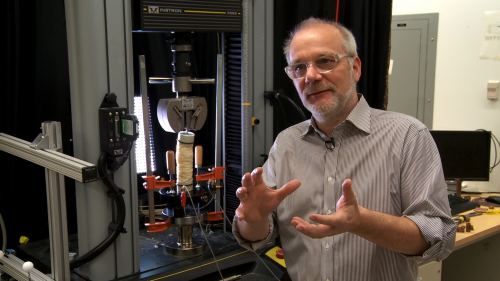Professor discusses physics of granular materials at AAAS meeting

Pour sand from a bucket and it flows like a liquid, but stand on it and it supports weight like a solid. This unusual behavior is a property of granular materials, and it is one of the reasons Heinrich Jaeger, the William J. and Alicia Townsend Friedman Professor in Physics at the University of Chicago, has chosen to focus on these types of materials in his research.
Jaeger will present a lecture on "Granular Matter: From Basic Questions to New Concepts and Applications," at the 2014 annual meeting of the American Association for the Advancement of Science.
The subject has led his group from the basic science of granular materials to their technological applications. The study of these applications then steered them back to new basic science questions. In his talk, Jaeger will highlight the cyclical nature of his process. "It's not just a one-way street or even a two-way street, but it's really a circular thing," said Jaeger.
Granular materials are special because they are non-equilibrium materials—unlike crystalline materials, they will never be able to reach their optimal state of packing. "It's kind of the prototypical material that cannot find its sweet spot," Jaeger said. Granular materials have been used as a model system to help scientists study materials that behave similarly, like glass, which is structurally like a liquid, but behaves like a solid.
The group has been studying a property called "jamming," which describes the transition from liquid- to solid-like behavior in granular material. A traffic jam is one familiar example of this phenomenon—cars will flow smoothly until a phase transition occurs, and gridlock descends.
This basic science has led the group to new applications for these materials. Jaeger will discuss his group's collaborative work with robotics developers toward integrating the property of jamming in robots. Robots are typically made of rigid structures, but jamming robots can become soft, reshape themselves, and become hard again. One application the group has worked on is a robotic gripper. Instead of stiff fingers, which may have trouble grasping complex shapes, a soft gripper can be used to mold around an object, and jamming can then be induced to tighten its grip.
The question of how to optimize materials for use in applications like these brought Jaeger's group again back to fundamental science. They realized that scientists knew how to go from the properties of individual particles to the behavior of the granular material made up of those particles, but they didn't know how to start with a desired behavior from a material—for example, a material which is strong under compression—and determine how to design the particles to get that result.
To understand how to solve this problem for granular materials—and for materials science problems in general—Jaeger's group is now working with evolutionary algorithms, using computers to model evolutionary-type processes to generate the optimal particle shape for a given application.
"All of this came out of essentially a basic fundamental quest to understand a glass transition," Jaeger said.—Emily Conover
Provided by University of Chicago



















